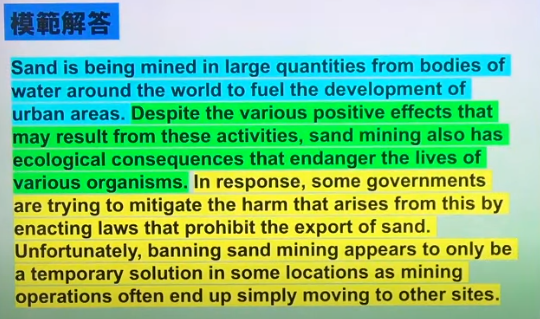EIKEN Grade 1 Writing Added ‘Summary’ task to existing ‘Opinion’ task.
Sample question
● Read the article below and summarize it in your own words as far as possible in English.
● Suggested length: 90–110 words
● Write your summary in the space provided on your answer sheet. Any writing outside the space will not be graded.
「5 Tips for Answering Summary Questions」
① Identifying the Main Argument ⇒ After reading the entire paper, the author’s main argument is identified. The summary revolves around this main argument.
② Abstracting Specific Terms ⇒ Specific terms and proper nouns are paraphrased into more general or abstract expressions. For example, specific names like “Lake X” or “River Y” are changed to words like “water bodies” and abstracted.
③ Constructing Logical Structure ⇒ Care is taken to establish a logical structure, including causal relationships, to maintain the same logical flow as the original text. The summary simplifies the presentation of the main argument and the flow of the original text. Paragraph One Summary → Paragraph Two Summary → Paragraph Three Summary
④ Eliminating Redundancy ⇒ Redundant information and repetitions are removed, focusing on essential information. By consolidating repeated sentences or similar words into more general terms, the summary is made concise.
⑤ Confirming Coherence ⇒ Checking if the summary conveys the author’s main argument without requiring prior knowledge.
▮ Sample Article (312 words )
Poyang Lake is China’s biggest freshwater lake. Although people have fished it for generations, these days, a new resource is being removed-sand. Up to 10,000 tons of sand are dug up from the lake floor per hour, making this the world’s largest sand mine. Much of the sand is shipped to Shanghai—a city whose population has risen by 7 million since 2007-where it is used in the construction of high-rises, roads, and other structures. Massive mining operations exist not only in China but also in other nations, including Australia and the United States. GlobaJly, the largest importer of sand is Singapore, which has used the resource to increase its territorial landmass by 20 square miles.
The consequences of sand mining are a major concern. Removing sand from water bodies increases water sediment,
blocking out sunlight; this interferes with underwater plants’production of oxygen, making survival for fish and other organisms difficult. ln the case of Poyang Lake, sand removal has made the channels leading out of the lake much deeper and wider, doubling the amount of water flowing out\var·d. Consequently, the lake’s water level has dropped dramatically. This
threatens the water supply to neighboring wetlands, which are home to numerous bird species and other wildlife.
Many countries are becoming increasingly aware of the damage caused by sand mining. Demand for the resource has
taken a toll on Indonesia, Malaysia, and Cambodia, which have ba皿ed sand exports in efforts to preserve local ecosystems. However, increasing demand means that when mining stops in one area, other areas take on the burden of supply. China’s Yangtze River, for example, was fom1erly a major sand-mining site, but by the late 1990s so much had been removed that bridges collapsed along with large sections of the riverbank. When sand mining was banned on the Yangtze in 2000, operations
shifted to Poyang Lake.
▮ Sample Answer (96 words)
Sand is being mined in large quantities from bodies of water around the world to fuel the development of urban areas. Despite the various positive effects that may result from these activities, sand mining also has ecological consequences that endanger the lives of various organis1ns. ln response, some governments are trying to 1nitigate the harm that arises from this by enacting laws that prohibit the export of sand. Unfortunately, banning sand mining appears to only be a temporary solution in some locations as mining operations often end up simply moving to other sites.
==============================================
Constructing Logical Structure ⇒ Care is taken to establish a logical structure, including causal relationships, to maintain the same logical flow as the original text. The summary simplifies the presentation of the main argument and the flow of the original text. Paragraph One Summary → Paragraph Two Summary → Paragraph Three Summary
Sample Answer

Evaluation Criteria
Answers will be graded on four aspects: content, structure, vocabulary, and grammar.
Each perspective is evaluated on a 5-point scale from 0 to 8 points, with a maximum score of 32 points.







